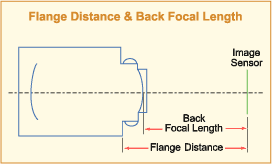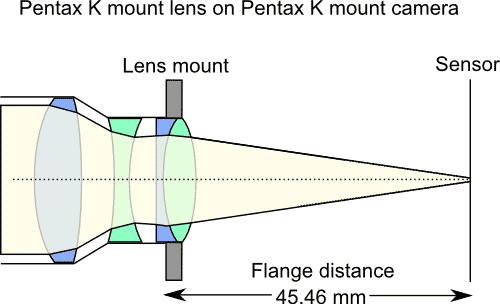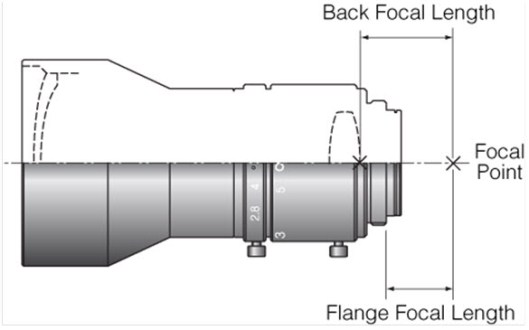Flange focal distance
The flange is a term used in technical optics. It defines the distance between the image plane, that is the film or the image sensor, and the mounting surface of the lens.
In many optical devices, the flange focal length is a fixed size. However, this is not always the case.
Photo technology
The back focal length is the distance between the film plane (or sensor plane ) behind the contact surface of the interchangeable lens at the front of the camera. Different camera systems use different focal lengths, which should be kept as up to tolerances of ± 0.01 mm so that the infinity setting of the lens is maintained. To adjust the flange focal length, there are special gauges, deviations from the standard camera if necessary, be compensated by the camera service by very thin washers under the bayonet ring. The position of the film plane is usually by a line with centered small group - marked on the camera body - usually the top. This brand allows a reading accuracy of 0.2 mm at best, and is the basis for the distance measurement for object photographed equal to the adjusted distance the focusing ring of the lens, especially relevant for macro shots and other special tasks to calculate the magnification and the localization of the minimum focusing distance. This distance corresponds to the simplest optics ( thin lens or pinhole camera ) of the total image width object distance.
In general, it should be noted that reflex ( SLR) due to the mirror box have a significantly larger flange than rangefinder cameras. This is especially true for medium-format SLR cameras such as the Pentacon Six.
From the point of allowing maximum adaptation options for external lenses on a camera system, the flange of the camera should be as small as possible, which, thus, the oscillating mirror does not collide with the lenses, sometimes can only be reached by a special folding sliding mechanism for the oscillating mirror. Only if the flange of the camera is smaller than that of the lens, an adapter ring can build that balances between the camera lens and placed exactly the difference of the focal lengths. Otherwise, however, they lose, since the image plane of the objective in this case would be behind the plane of the film and the sensor, the focusing possibility to infinity. Thus, for many medium format lenses with their large contact dimensions and image circles using special adapter to use well adapt to SLR film cameras and even a tilt and shift lenses, while the reverse is hardly possible.
On the other hand, allows a larger back focus of the camera during an otherwise identical design effort greater return mirror, which is in terms of an exact match as possible from the viewfinder and film an advantage. For digital SLR 's even the added obstacle of the beam path in a shorter back focus may " oblique ", which can be problematic for some image sensors, since they have usually ( unlike the classical analogue photography on photosensitive film ) angle-dependent sensitivities.
In practice, however, the advantages and disadvantages of the combination of different focal lengths are small. Nevertheless, there are cases where certain lenses are constructive not be combined with certain camera systems because their focal lengths are too short or too long. For example, Nikon SLRs have a rather long back focus, which greatly restricts the choice of foreign lenses which can be used with these cameras.
Video technology
On cameras with fixed lens back focus usually is fixed. Interchangeable lenses with standardized bayonet, such as B3 or B4, can be used with cameras from different manufacturers. In these lenses back focus can be set manually, for example to compensate for manufacturing tolerances and temperature variations can.
When setting the back focus the rearmost lens group is moved just before the image sensor or film in the direction of the lens axis. Only when correctly adjusted the back focus set of field at all focal lengths is constant.
The Auflagemaßring located at the rear end of the lens. Often, there is still a Ratcheting additional ring, which is used for macro shots. This ring moves in the same lens group as the Auflagemaßring, but in contrast to this can be locked in the starting position again when the macro function is no longer needed.
To adjust the back focus an image with high contrast is required (usually a so-called Siemens star ). The asterisk is placed to set 3-5 meters in front of the camera. The camera should be on the same level as the Siemens star. The lighting shall be such that the image can be seen well in fully open aperture. If it gets too bright, it is recommended that upstream an ND filter or adjust the shutter.
CRT monitors that offer the blue-only function, due to a really undesirable side effect show significant flicker in the Siemens star, if the focus is right. This feature helps you to adjust the back focus. LCD monitors can not do this, even if they have a " Blue Only " button.
If the flange is not true, once a set of field is not correct for the entire focal length range. This is particularly zooms, so zooming in "ON" a problem since you would have to re-adjust the focus manually. Also, you have to at the sharpness assessment of the image on the viewfinder or monitor leave, which often do not allow for proper sharpness control.









